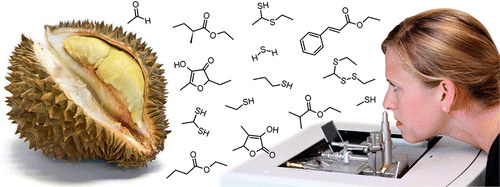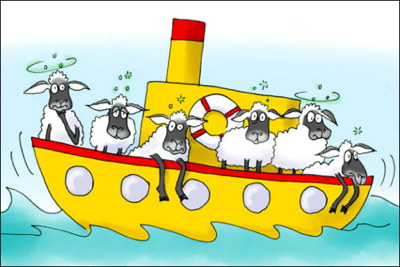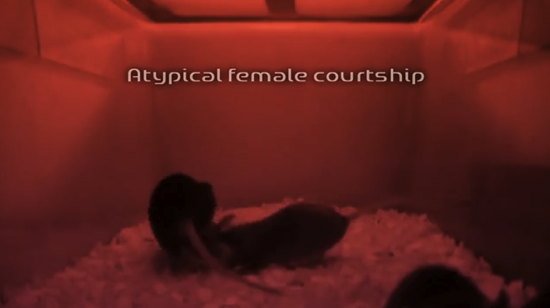Science
What Makes Durian Stinky?
Durian is reputed to be the stinkiest fruit in the world, so researchers at the German Research Center for Food Chemistry recently set out to find out exactly what makes it so malodorous. They write in the Journal of Agricultural and Food Chemistry:
Their investigation involved a) shipping Durian by air freight from Thailand to Germany; b) extracting pulp from the fruit; and then c) analyzing the pulp by means of a "Trace GC Ultra gas chromatograph" equipped with a "tailor-made sniffing port":
This effort yielded "several new aroma compounds with interesting odors," but the authors of the study caution that further investigations are still required in order to "unequivocally assess the contribution of individual odorants to durian aroma."
Posted By: Alex - Sun Dec 02, 2012 -
Comments (7)
Category: Food, Science, Experiments
The Weight of Handwriting
Click to enlarge. From The Outline of Science, 1922. One of these would be useful for determining exactly how much weight you gained over Thanksgiving.
Posted By: Alex - Fri Nov 23, 2012 -
Comments (5)
Category: Inventions, Science, 1920s
Feeling Like a Rat
Rats use whiskers to feel around in the dark. They navigate by "whisking" — moving their whiskers rapidly back and forth. Humans, however, don't have whiskers. But could people learn to navigate in the dark using artificial whiskers? That was the question posed by a recent experiment published in the Journal of Neuroscience.The researchers attached plastic whiskers to the fingers (not the cheeks, unfortunately) of blindfolded volunteers. These volunteers were then asked to try to identify the relative position of several poles on either side of them. The researchers discovered that the volunteers skill at this task improved significantly over time. So they were learning to use whiskers just as a rat would. The practical value of all this is that the researchers hope to develop finger whiskers for blind people.
Incidentally, if you read the abstract of the experiment, you would never know it had anything to do with rats and whiskers. The researchers describe their experiment as a study of "motor-sensory interactions in humans using a novel object localization task that enabled monitoring the relevant overt motor and sensory variables."

Posted By: Alex - Thu Nov 08, 2012 -
Comments (8)
Category: Animals, Science, Experiments
Decomposition of a Pig Underwater
Back in Jan 2009, I posted a video showing the decomposition of a pig. Here's a similar video, also showing the decomposition of a pig, but underwater this time. It was an experiment conducted in Feb 2012. The pig was in a cage to stop sharks from getting to it. Watch to the end to see the surprise visitor.
Posted By: Alex - Tue Oct 30, 2012 -
Comments (4)
Category: Death, Science, Experiments
3D Bioprinter

3D bioprinters are being developed that could manufacture medicines and vaccines according email specs from their basic components. They could be used in pharmacies and perhaps even homes to print out refills. More 'replicator' science.
Posted By: Alex - Mon Oct 29, 2012 -
Comments (4)
Category: Science
Seasick Sheep
University of Queensland PhD student Eduardo Santurtun is conducting research into whether sheep get seasick. Or rather, the effect of "ship motions" on sheep. But he's not studying the sheep on an actual ship. Instead, he's created a contraption (a modified flight simulator) that replicates the roll, pitch, and heave of a ship. His subjects spend hours a day inside this thing being gently see-sawed up and down, back and forth. This is all being done to help the sheep, not hurt them. His research is supported by the Centre for Animal Welfare and Ethics, which is concerned about sheep getting seasick and dying as they're transported from farms in Australia to consumers around the world. [qt.com.au, abc.net.au]
Posted By: Alex - Mon Oct 22, 2012 -
Comments (8)
Category: Animals, Science, Experiments
From Thin Air

Could it really be true? Fuel from air!
Posted By: Alex - Thu Oct 18, 2012 -
Comments (15)
Category: Science
Mutant Genital-Biting Female Mice

After tweaking the genes of some laboratory mice, Swiss scientists have produced female mice that exhibit an unusual sexual behavior. They bite the genitals of their partners. The male mice respond by running away in terror.
This unusual trait is passed through the female line, from mother to daughter. The scientists aren't sure if humans have a similar 'genital-biting' gene, but they're hopeful that "future studies addressing the genetic basis of behavior in humans may be very informative in this respect."
The video is worth watching just to see the female mice going at it.
Posted By: Alex - Tue Sep 25, 2012 -
Comments (13)
Category: Animals, Science, Genitals
Your Brain on Mescaline
In the early 1950s, German photographer Leif Geiges created a series of abstract images in order to try to portray "exactly what the mescaline subject sees and hears during the course of his artificial psychosis" — as Newsweek put it, which ran his images in its Feb 23, 1953 issue. This was before mescaline was made illegal, back when psychiatrists still believed that the experience of taking mescaline approximated the mental state of a schizophrenic and therefore could be of great experimental value.As for the mescaline imagery itself, Newsweek explained:

"Wallpaper patterns come to life, change to demoniac caricatures, threaten immediate destruction"
More in extended >>
Posted By: Alex - Tue Sep 18, 2012 -
Comments (12)
Category: Dreams and Nightmares, Drugs, Psychedelic, Photography and Photographers, Science, 1950s, Brain, Mental Health and Insanity
How the Marsh Mongoose catches prey

The Marsh Mongoose (Atilax paludinosus), also known as the African Water Mongoose, has an unusual method of catching its favorite food (birds). It makes its butt look like a piece of ripe fruit, which tempts birds over to investigate — and fall right into its trap. Jonathan Kingdon, author of East African Mammals, explains:
According to Animal Diversity Web, the Marsh Mongoose also has another odd trick:
Goes to show that you really can't compete with Nature for weirdness.
Posted By: Alex - Sun Sep 16, 2012 -
Comments (5)
Category: Animals, Freaks, Oddities, Quirks of Nature, Science

| Who We Are |
|---|
| Alex Boese Alex is the creator and curator of the Museum of Hoaxes. He's also the author of various weird, non-fiction, science-themed books such as Elephants on Acid and Psychedelic Apes. Paul Di Filippo Paul has been paid to put weird ideas into fictional form for over thirty years, in his career as a noted science fiction writer. He has recently begun blogging on many curious topics with three fellow writers at The Inferior 4+1. Contact Us |





